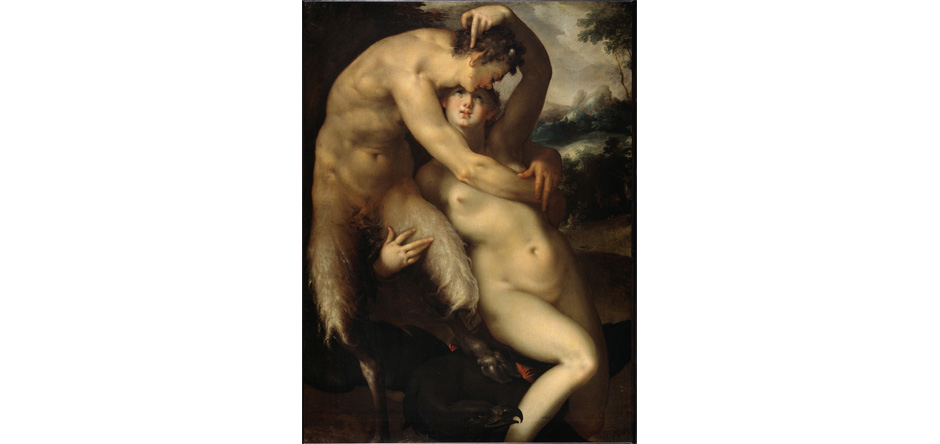There can be no doubt where Bartholomeus Spranger’s artistic passions lay.
A pert bosom, a dimpled buttock, the creamy dunes of a woman’s back, her opalescent flesh offset by the tawny musculature of an ardent lover.
Or perhaps it would be more accurate to say that this is where his patrons’ artistic passions lay, for the Flemish artist (1546-1611) created what Sally Metzler – guest curator of the luscious Spranger exhibit at The Metropolitan Museum of Art – describes as art reservata, art for the one-percenters of his day. They included Pope Pius V and Cardinal Alessandro Farnese, for whom Spranger painted sensuous religious works (the contrapuntal form of the dead Jesus in “The Lamentation of Christ,” circa 1576, is particularly exquisite), as well as Holy Roman Emperor Maximilian II.
But perhaps no one was better attuned to Spranger’s aesthetic sensibilities – and vice versa – than Maximilian’s lascivious son and successor, the anything-goes Rudolf II. An eternal, perhaps bisexual, bachelor with a string of mistresses and natural children, Rudolf was also an erudite man for whom no idea was so terrifying that it could not be entertained. That included the trending alchemy, which purported that base metals could be turned into gold.
Spranger’s art, then, wasn’t just about sex. Or rather, the sex was symbolic of love’s alchemy. In the exhibit catalog, Metzler quotes Ebreo’s “Dialoghi d’amore”: “The union of copulation … makes possible a closer and more binding union, which comprises the actual conversion of each lover into the other.”
Still, sex and sexuality are at the heart of Spranger’s art, which marries the elongated Mannerist figures of El Greco and Parmigianino to the swarthy physicality of the subjects portrayed by Giulio Clovio, the “Croatian Michelangelo.” In “Diana” – an oil painting of the late 1590s-early 1600s that was intended for the private delectation of Rudolf II, who held court in Prague – the chaste goddess of the hunt sports a corset and undulating folds of red and green satin that offset her full, high breasts, exposed save for a bit of gauzy, beaded fabric. In case we miss the point, Diana accentuates her erect right nipple with her right thumb while one of her hunting dogs nuzzles her, mouth agape. Her rapt gaze may be heavenward but her full, bow-shaped lips and crimson cheeks remain rooted in this world, as does the phallic bow she holds in one hand and the crescent moon, one of her attributes, that crowns her dark-gold tresses. (Hundreds of years later, a similar crescent tiara would appear in John Singer Sargent’s witchy “Madame X” and certain photographs of Jacqueline Kennedy Onassis.)
It’s not so surprising that Spranger would give Diana (Artemis in Greek mythology) the pinup treatment usually reserved for her sister Venus. After all, the bathing Diana – so affronted by the hunter Actaeon glimpsing her naked that she turns him into a stag – has been a favorite of artists, Spranger included. What is unusual, however, is the depiction of their sister Minerva (Athena in Greek mythology) – the virgin goddess of wisdom, arts and crafts and judicious warfare, whose narrative generally contains no nude scenes. Indeed, her peekaboo breastplate in several Spranger canvases, with its fearsome head of Medusa underscoring her bared breasts, attracts more than it repels.
Even the garb for Spranger’s virgin saints reveals more than it conceals, sexualizing pristine flesh in an alchemy of sacred and profane love.
Elsewhere in Spranger’s work, marbled females are showcased against darker males, who wrap powerful forearms beneath their lovers’ breasts or thrust shapely legs out at the viewer in a preview (or perhaps postlude?) of the sex act itself. The animalistic swarthiness of the men – as per his self-portrait (1585-86), Spranger himself was a brunet; his beloved wife Christina, a blonde – and the pearlescence of the women might be one more pair of mighty opposites Spranger and his alchemy-loving patron were playing with. Dark and light. Male and female. Strong and weak. Hard and soft.
The dualities are upended in Spranger’s gender-bending “Hercules and Omphale” (circa 1585, oil on copper), in which the captive Hercules dons feminine pastels and takes up the spindle while his commanding queen, Omphale, her nude backside to us, clutches his lion skin and hoists his phallic club as she looks provocatively over one shoulder. She seems so girlish and he, hulking and older. So who’s the dominant and who’s the slave in this 50 shades of green, pink, gold – anything but gray?
You look at this triumphant depiction of molded flesh and realize that the real alchemy here is not sex but art.
For as curator Metzler writes, Spranger “transformed simple materials – pigments and inks – into erotic gold.”
“Bartholomeus Spranger: Splendor and Eroticism in Imperial Prague” is on view at The Metropolitan Museum of Art in Manhattan through Feb. 1. For more, visit metmuseum.org.





